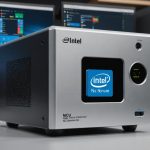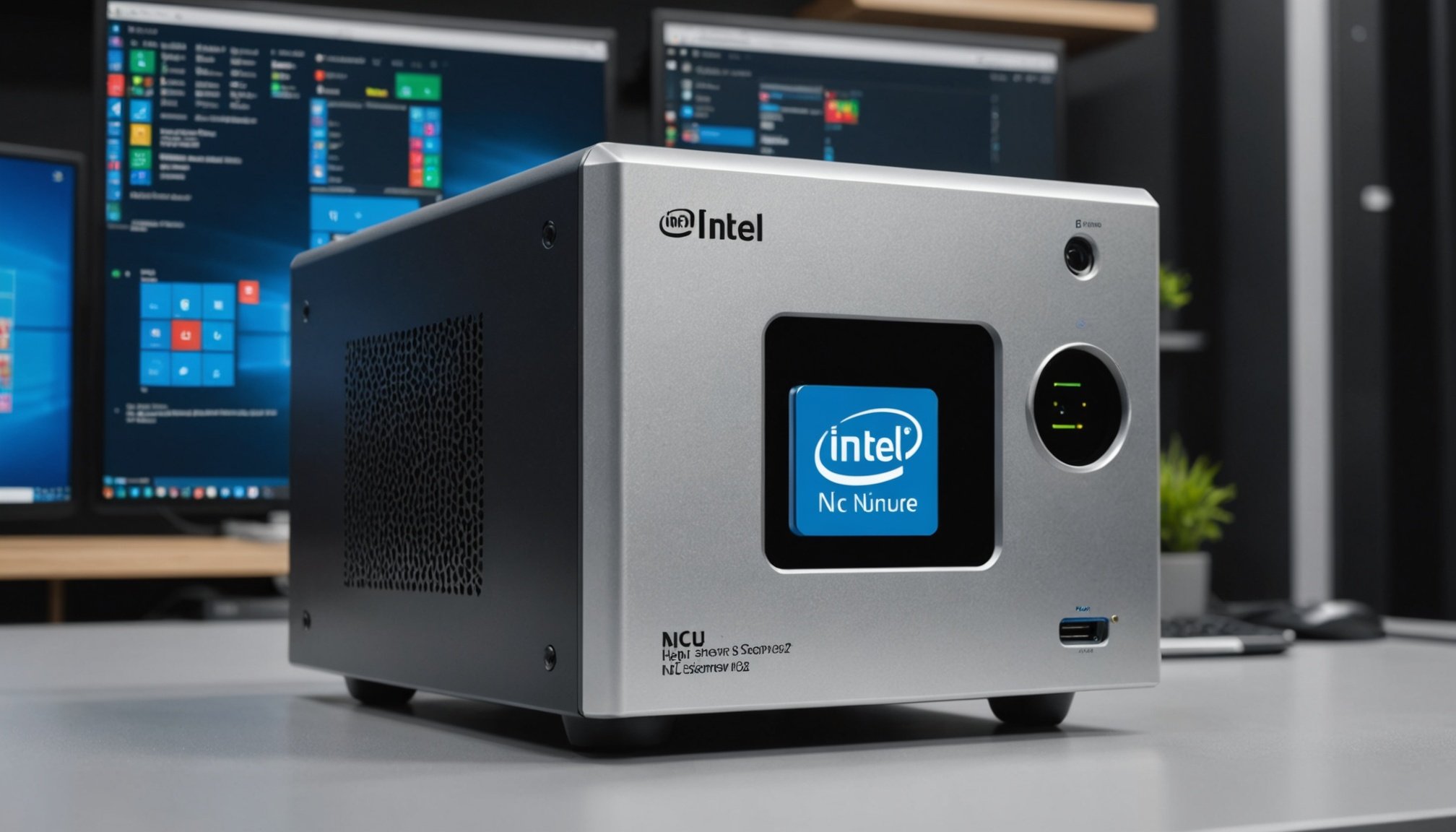Overview of Intel NUC for File Server Applications
The Intel NUC is a compact computing solution that offers substantial potential for file server applications. Equipped with the latest processors, the Intel NUC is engineered to deliver performance, energy efficiency, and space-saving advantages. It supports high-speed memory and robust storage capabilities, accommodating various file server demands seamlessly.
One of the primary hardware benefits of using an Intel NUC for file servers is its compact design. Its minimal footprint makes it perfect for environments where space is a premium asset. Moreover, the energy-efficient design helps reduce operating costs over time, making it a viable long-term solution.
Also to see : Creating a secure remote work environment: essential tips for harnessing the power of ubiquiti unifi dream machine
When compared to traditional file server hardware, the Intel NUC provides a clear advantage in terms of flexibility and ease of setup. Traditional servers often require dedicated server rooms and extensive cooling, whereas the Intel NUC can operate efficiently in a less controlled environment. Moreover, its quiet operation is ideal for small office spaces.
Additional benefits include simplified maintenance, as the modular design allows for straightforward upgrades, enhancing its adaptability. The Intel NUC’s scalability makes it suitable for different file server applications, catering to both small businesses and more extensive enterprise networks. This innovative approach to server hardware offers a viable alternative to more cumbersome traditional systems.
In parallel : Ultimate guide to dual booting: seamlessly install windows 10 and linux mint on your hp pavilion laptop
Installing Windows Server 2022 on Intel NUC
Setting up Windows Server 2022 on an Intel NUC requires some preparation. To ensure a smooth installation process, gather necessary prerequisites such as a compatible Intel NUC model, a copy of Windows Server 2022, and peripheral devices like a keyboard and mouse. It’s crucial to verify that the NUC meets the system requirements for Windows Server 2022.
Once prerequisites are secured, begin the installation process. Start by connecting the NUC to a display, and insert the bootable USB drive containing Windows Server 2022. Power on the device, and access the boot menu by pressing the appropriate key (typically F10) during startup.
In the installation wizard, follow these steps:
-
Select language, time, and keyboard preferences.
-
Click “Install Now.” Enter the product key if prompted.
-
Choose the correct Windows Server 2022 edition suited to your needs.
-
Accept license terms and proceed to “Custom Installation” to select the installation drive.
-
Follow on-screen instructions to complete the installation.
During setup, configure recommended settings to optimise performance. Configure basic server roles, enable automatic updates, and set up network connections. Install necessary drivers for the Intel NUC from the manufacturer’s website to ensure all hardware functions properly after installation.
Configuring Network Settings for Optimal Performance
Effective network configuration is crucial for the seamless operation of file servers. It plays a pivotal role in ensuring that users experience minimal interruptions and achieve optimal data transfer speeds. By carefully adjusting your TCP/IP settings, you can significantly enhance network performance and reliability.
Start by focusing on performance optimization through the precise configuration of TCP/IP parameters. For a file server, these settings determine how data packets are sent and received over the network. Key adjustments include setting appropriate sizes for buffer and window fields, enabling selective acknowledgments, and fine-tuning retransmission timers to minimize latency and maximize throughput.
To achieve the best performance, consider these best practices for network optimization on a file server:
- Enable Jumbo Frames, if supported, to allow larger data packets and reduce overhead.
- Use a dedicated network interface card (NIC) for handling file transfers, reducing network congestion.
- Regularly update firmware and drivers to ensure the latest performance enhancements are in place.
Adopting these strategies not only boosts file server efficiency but also lays the groundwork for future scalability. Proper network configuration and performance optimization are not merely technical tasks but investments in an organization’s operational success.
Implementing Security Measures
Enhancing file server security is paramount for organisations relying on Windows Server 2022. Essential steps include configuring robust user access controls and permissions to safeguard sensitive data effectively. It involves establishing precise access rights whereby users see only what they are permitted to access, mitigating unauthorised intrusions.
To configure user access controls, consider utilizing Group Policy, which aids in defining user permissions in a centralised manner. Establish user groups aligned with specific roles, and assign access based on necessity, maintaining a principle of least privilege. This ensures users access only the files they require, thus, enhancing file security.
Leveraging Windows Defender is crucial for comprehensive protection. It provides real-time protection against threats, including malware and spyware, making it an invaluable tool in the security arsenal. Regularly updating Windows Defender ensures the software has the latest threat definitions, crucial for maintaining robust protection.
In addition, consider integrating other security tools such as firewalls and encryption technologies, which add layers of protection. Implementing these measures collectively fortifies the environment, thus protecting against unexpected breaches. Employing these strategies ensures business continuity and data integrity in a progressively digital landscape.
Performance Optimization Techniques
When it comes to file server efficiency, employing performance optimization strategies is crucial. For those using an Intel NUC, there are several methods to ensure exceptional results. One effective technique is hardware tuning, which involves upgrading components such as the RAM and SSD. Increasing the RAM capacity often improves the server’s ability to handle multiple requests simultaneously. Similarly, switching to a faster SSD can significantly reduce access times, enhancing overall server responsiveness.
Another aspect to consider is the use of specific monitoring tools aimed at assessing and maintaining optimal file server performance. Tools like IOPS calculators can evaluate input/output operations per second, providing insights into performance bottlenecks. Additionally, network monitoring software helps track data flow and detect latency issues, ensuring that the server’s performance remains consistently reliable.
Furthermore, implementing caching solutions can meaningfully boost file server efficiency. By storing frequently accessed data closer to the CPU, caching reduces the need for repetitive data retrieval from larger storage units, speeding up data access times.
Lastly, periodic hardware tuning adjustments and software updates ensure that the server stays up-to-date with the latest performance improvements. By maintaining a balanced approach that combines hardware upgrades and diligent monitoring, file servers can operate at peak efficiency, delivering seamless performance.
Compatibility Considerations with Windows Server 2022
Understanding compatibility issues with Windows Server 2022 is crucial for maintaining system efficiency. When deploying new software applications, users often encounter challenges due to certain applications not aligning with updated operating system protocols. These compatibility issues can lead to significant disruptions if not addressed proactively.
Ensuring hardware compatibility is equally important. As Windows Server 2022 introduces additional functionalities and features, some older hardware may struggle to support these updates. It’s advisable to verify that server components can handle the server’s capabilities to prevent any potential performance drawbacks.
To assist in this process, several tools are available for checking software compatibility. Tools such as the Windows Assessment and Deployment Kit (ADK) and Windows Server Catalog provide insights into whether existing software and hardware setups meet the necessary requirements for the newest server version. These resources can help in identifying potential compatibility issues early in the deployment phase and ensure smooth transitions.
By evaluating Windows Server features and requirements, users can prepare their systems efficiently and maintain operational continuity. Properly utilizing available tools reduces the frustration of unforeseen compatibility setbacks and supports informed decision-making, providing peace of mind and reliability when upgrading to Windows Server 2022.
Troubleshooting Common Issues
When dealing with file servers, several common issues can arise. Recognizing these early and knowing how to handle them is vital for maintaining smooth operations. Effective troubleshooting techniques can significantly reduce server downtime and improve performance.
Common File Server Issues
File servers often face problems such as connectivity issues, data corruption, and slow access times. Users may encounter scenarios where files become inaccessible or network speeds lag, affecting productivity. Identifying these symptoms promptly is the first step towards resolution.
Troubleshooting Guide
-
Connectivity Problems: Ensure that all cables are properly connected and network configurations are correct. If disconnections persist, restart network services and check DNS settings.
-
Data Corruption: Regularly back up important data and use file repair tools if corruption is detected. Implement data validation processes to prevent corruption.
-
Slow Access Times: Free up additional resources or upgrade hardware if necessary. Ensure that server processes are optimized.
Maintenance Tips
To prevent server downtime, adopt regular maintenance practices. Routinely update software to protect against vulnerabilities, clear outdated logs, and perform hardware checks. Monitoring system performance and conducting periodic audits can also preempt many common server issues before they escalate.
Case Studies and Practical Examples
Understanding how different organizations have successfully implemented Intel NUC-based file servers can provide valuable insights for your own projects. File servers powered by Intel NUC devices have become a popular choice due to their compact size, energy efficiency, and cost-effectiveness. Let’s explore some real-world examples and implementation strategies that highlight their versatility.
Imagine a small business aiming to establish an efficient storage solution without a large equipment footprint. They opted for an Intel NUC, leveraging its small form factor to fit seamlessly into their limited office space. Using the Intel NUC as a file server, they managed to optimise data storage and streamline workflows. This approach underlines one key advantage: making the most of available technology while maintaining a clean, minimalist work environment.
Another scenario involves a creative agency that utilised a robust Intel NUC setup for handling large design files and multimedia content. By setting up RAID configurations, they ensured data redundancy and secured critical assets against potential loss. This case study demonstrates how tailored implementation strategies can effectively meet specific needs.
These tangible experiences provide critical lessons. Selecting the right implementation strategies, understanding the intricacies of different setups, and analysing the real-world examples can guide you towards a successful deployment of Intel NUC file servers in your unique environment.






